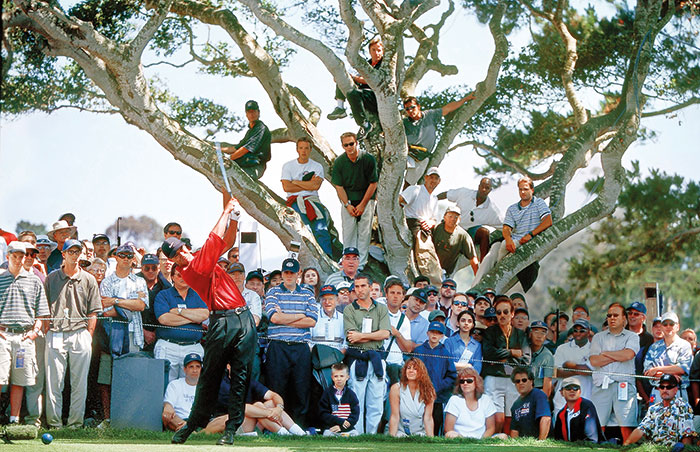The second Major of 2016 is around the corner on a revamped course.
Legend has it that on the final hole of the final round in the 1969 US Open in Houston, Texas, as the crowd rushed to get a glimpse of what was happening ahead of them, a marshal shouted at 14-year veteran of the US Army, Orville Moody, telling him in no uncertain terms to ‘get behind the ropes!’
The marshal was quickly put in his spot. Moody was the tournament leader and needed a par on that final hole to win. He did just that, getting home by one shot for the only victory he recorded on the PGA Tour.
The US Open is the second Major of the year and each year it’s played on a different course – Oakmont Country Club will be hosting it for a record ninth time this time round – and it’s often a tough set-up for the golfers. Any final tally that sees a golfer in the red numbers will be sure to earn himself a healthy payday, just like Jordan Spieth did last year when he held off Louis Oosthuizen and Dustin Johnson to win by one shot and pocket $1.8-million.
One of the formats unique to the US Open is that, should there be a tie for the lead after the regulation 72 holes, an 18-hole playoff is held on the Monday. Ernie Els, in 1994, experienced just that when he won his first Major – ironically, it was at Oakmont CC – by seeing off Loren Roberts and Colin Montgomerie on the Monday.
Last year’s event was held at Chambers Bay and while Spieth won to collect his second Major in a row after donning the Green Jacket at The Masters, the course was lambasted. ‘You don’t bring the US Open to golf courses like this. This is devastating,’ South African legend Gary Player said. ‘To see a man miss the green by one yard and end up 50 yards down there, caddies falling and hurting their ankles and knees, players falling … this is terrible. It’s actually a tragedy – 7 900 yards long. An average golfer playing this course, a 15 or 16 handicap, he is going to shoot 110 and not go home a happy man.’
In response, Jay Blasi, a member of the design team behind Chambers Bay, took to Twitter. ‘Greatly respect @garyplayer and agree with many of his goals for golf but he is uninformed as it relates to @ChambersBayGolf #studyfirst’.
Player hasn’t been alone in the criticism. Spieth had referred to the 18th as ‘a dumb hole’ when played as a par four, while Hendrik Stenson reckoned the greens were like ‘cabbages’ and Rory McIlroy referred to them as ‘cauliflower’.
This year Oakmont is unlikely to be as controversial, although it’s different in set-up to when the last US Open was played there back in 2007; on that occasion Angel Cabrera upset the dominant Tiger Woods.
‘The course is virtually unchanged since 2007, but there are a few changes since the Women’s US Open in 2010,’ said Jeff Hall, managing director of the USGA’s rules and competition committee. ‘Perhaps the only real change is the fairway bunkers.
‘Certainly, Oakmont has become an industry leader in tree removal. It’s a wonderful look from the clubhouse, because you can effectively see every hole on the golf course.
‘We did embrace on a project to remove the trees, especially around hole12,’ said John Zimmers, Oakmont’s course superintendent. ‘It’s really opened up a great vista, and we looked at the old aerials when you could see 17 of 18 holes.’
Added Hall: ‘The only thing we wanted to do better was get the strategic bunkers to be more in play. So, the club embarked on a programme to reduce the rough height as it leads into the bunkers. It promotes golf balls that are rolling toward the bunker to get into the bunkers as opposed to being held up by the rough.
‘You’ve really got to be precise playing this golf course. The second hole is a great example. Even at 340 yards, it’s not a throwaway by any stretch,’ Hall added.
Joint favourites in the betting are Spieth and McIlroy, while Jason Day is 9-1. Fourth favourites at 20-1 are Johnson, Rickie Fowler and Justin Rose, while from a South African perspective Branden Grace is 40-1, Oosthuizen 50-1, Charl Schwartzel 66-1 and Els is 150-1.
There have been some incredible moments at the US Open since the first one was played in 1895.
Perhaps the most famous of all, which spawned the 2005 movie The Greatest Game Ever Played featured the 20-year-old American Francis Ouimet. His caddie was a 10-year-old kid. He worked at a sporting-goods store and needed to ask his boss for time off to play in the Open. Yet, when he out duelled British legend Harry Vardon down the stretch of the 1913 Open in Brookline, America finally fell in love with golf. In the 10 years after Ouimet’s victory, the number of Americans playing the sport tripled and public courses popped up across the country. As the World Golf Hall of Fame put it, Ouimet’s win swept away ‘the notion that golf was a stuffy game for the old and rich’.








